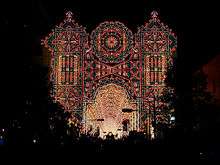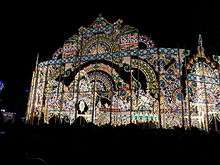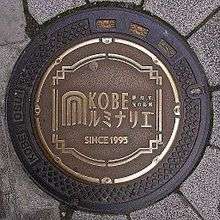Kobe Luminarie



Kobe Luminarie (神戸ルミナリエ) is a light festival held in Kobe, Japan, every December since 1995 to commemorate the Great Hanshin earthquake of that year.[1] The lights were donated by the Italian Government and the installation itself is produced by Valerio Festi[2] and Hirokazu Imaoka.[3] Over 200,000 [4] individually hand painted [5] lights are lit each year with electricity generated from biomass in order to stay environmentally friendly.[1]
Lights are kept up for about two weeks and turned on for a few hours each evening. Major streets in the vicinity are closed to auto traffic during these hours to allow pedestrians to fill the streets and enjoy the lights. It is viewed by about three to five million people each year.[6]
Symbolization
When the Great Hanshin Earthquake struck Kobe on January 17, 1995, it left more than 6,000 dead and caused $100 billon in damages.[7] Since many had to live in darkness due to supply cuts in electricity, gas, and water, the idea of putting up lights acted as a symbol of hope, recovery, and renovation.[5][7] Though it was only supposed to take place once, strong popularity and demand from citizens encouraged the continuation of luminarie to become an annual event.[1]
Silent prayers to victims of the earthquake takes place in the opening ceremony, and a memorial naming those who were killed is posted during the night.[7]
Tohoku Initiative
In the 2011 luminarie, the same year as the Tohoku earthquake and tsunami, a special exhibition was held to raise money for its victims. In the 2012 luminarie, drawings by children from that region were used to make lanterns displayed at the event.[4]
Tourist Attraction
The Hanshin Earthquake left Kobe at a slump with tourist attractions for obvious reasons. One of the factors that brought tourism back to Kobe was the sincerity of the luminarie event in honoring the victims of the earthquake.[8]
The event attracts around 4 million people to Kobe every year and raises $1.3 million in donations and $6.1 million in sponsorship and merchandise sales.[7]
The table below indicates the number of people attending the luminarie event each year since 2004.[1]
| Year | Number of People |
|---|---|
| 1995 | 2,542,678 |
| 1996 | 3,855,665 |
| 1997 | 4,732,346 |
| 1998 | 5,163,716 |
| 1999 | 5,157,573 |
| 2000 | 4,737,907 |
| 2001 | 5,190,000 |
| 2002 | 4,640,000 |
| 2003 | 5,066,000 |
| 2004 | 5,383,000 |
| 2005 | 4,358,000 |
| 2006 | 4,650,000 |
| 2007 | 4,043,000 |
| 2008 | 3,755,000 |
| 2009 | 3,650,000 |
| 2010 | 3,434,000 |
| 2011 | 3,421,000 |
| 2012 | 3,401,000 |
| 2013 | 3,541,000 |
| 2014 | 3,444,000 |
The luminarie also has numerous sponsors. The following are just few of the tens of dozens of sponsors for 2012;[1]
- West JR
- Hankyu Corporation
- Nestle Group Japan
- Hanshin Electric Railway Co
- TOA (shares)
- Kadokawa Magazine Ltd.
- Sysmex Ltd
See also
References
- 1 2 3 4 5 Official Site (Japanese)
- ↑ Studio Festi Installations
- ↑ http://www.kicc.jp/ajisai/ajisai118.pdf
- 1 2 "Going Global", The Gold Coast Bulletin, 2012, December 22. Retrieved on 22 February 2013.
- 1 2 "Japan's Most Famous Festival of Lights", My Modern Met, 2012, November 7. Retrieved on 22 February 2013.
- ↑ Kobe Luminarie 2012
- 1 2 3 4 Gates, C. "Leading lights", The Press, 2011, April 29. Retrieved on 22 February 2013.
- ↑ “Recovery of japan tourism”, McClatchy - Tribune Business News, 2012, July 02. Retrieved on 22 February 2013.
External links
- Osaka Hikari Renaissance (English)—another light festival which takes place in December and January around Nakanoshima in central Osaka
| Wikimedia Commons has media related to Kobe Luminarie. |
Coordinates: 34°41′17.1″N 135°11′23.8″E / 34.688083°N 135.189944°E